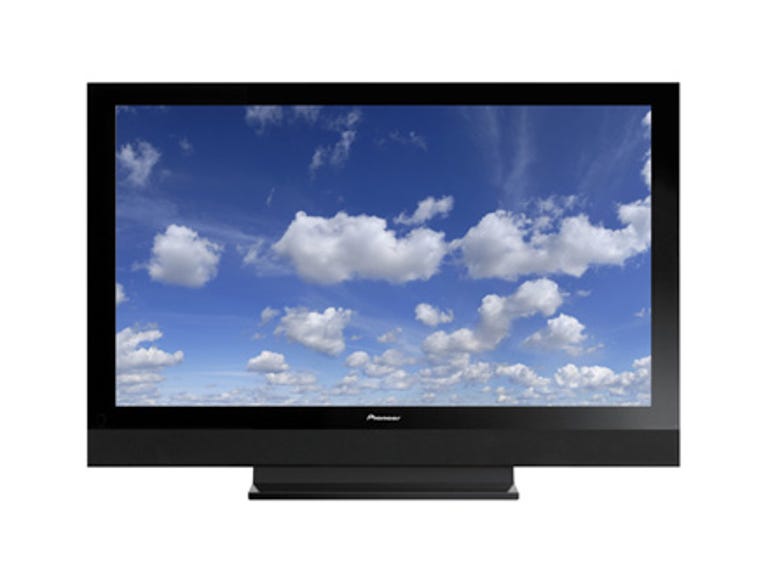 Why You Can Trust CNET
Why You Can Trust CNET Pioneer PDP-508XDA review: Pioneer PDP-508XDA
The Pioneer PDP-508XDA is without a doubt one of the best televisions ever released, with excellent black levels and oodles of detail.
It's not often that a home theatre product makes us completely rethink what we expect from the performance of our products. One so pants-wettingly good that we weep a little for the competition. And though the Pioneer PDP-508XDA is not perfect, it has single-handedly redefined what we expect television to look like.
The Good
The Bad
The Bottom Line
With the hyperbole out of the way -- let's get on with the review.
Design
This is not to say that the PDP-508XDA is ugly because it certainly isn't. Despite the need to dust it regularly, it's actually stylish in a very understated way. The speakers meld into the design seamlessly and the stand is also very unobtrusive.
The screen's true blacks are apparent from the get-go -- the screen is coated with a dark filter and it looks black without even turning the TV on. Despite this coating, the TV is still less reflective than other Pioneers, and so there's no real issue about seeing yourself during dark scenes.
Unlike the barebones approach of the Pioneer PDP-5000EX's remote, the Kuro's remote is packed with buttons. Unfortunately, unless you're familiar with TV pictograms you may need to look up what some of the buttons do. The remote also acts as a semi-universal remote as well, and will control Pioneer DVRs and disk players.
Features
As we've previously discussed, the Kuro range boasts an unheard of level of contrast -- in this case 16,000:1. In order to achieve this, the company rebuilt its TV from scratch. How did they do this? Well, there's a lot of technical gubbins that goes into the long answer but the short explanation is that there is a new "superchip" running the show, and a redesigned screen layer.
Unlike previous Pioneer models, the PDP-508XDA and the rest of the Kuro range now feature a HD tuner. No more need for an extraneous set-top box here.
If you're looking for connectivity, then the Pioneer has plenty: three HDMI version 1.3 ports, three component inputs, optical audio output, and a USB port for use with the onboard media gallery function.
The TV also caters to tinkerers, as it comes with a full set of ISF functions. While set-and-forgetters will be happy with the main picture modes, calibration can be as complicated or as easy as you like.
Performance
In the opening shot a tram travels under a bridge and when viewed on the 508XDA you can actually see the brickwork -- on our reference screen the bricks were obscured by a grey fog.
No matter what kind of source you have, the Pioneer should accept it. It will downscale full 1080p to its natural 1365 x 768 resolution, and it does a marvellous job of this. We watched our old favourites -- the King Kong and Mission Impossible III HD DVDs -- simultaneously on this TV and our reference 5000EX. After calibrating both, the enhanced black level of the new Kuro was immediately obvious. And it wasn't at the expense of detail -- dark and bright images alike came to life on the new TV. Blues in particular were richer, and skin tones more natural. Detail levels were also very good, though the 1080p 5000EX still has a very thin advantage here with 1080p content.
The Pioneer also accepts a PC input, whether by HDMI or VGA, and we found it does this quite well. Text was relatively sharp and Vista found and matched the native resolution automatically. The only thing we noticed was a tendency for self-noise on lighter sections of the screen and around text -- a sort of mosquito buzzing. It was very subtle but could get annoying if you choose to use this as your main monitor.
Gaming was a very enjoyable experience on the 508XDA -- we used a PlayStation 3 to play Motorstorm and the combination of sound and vision helped completely envelop us in the action.
Watching TV through the onboard tuner was a little disappointing after watching true HD content. Though many channels show HD content through the day it is usually of poor quality in comparison to Hollywood movies. Despite this, we did notice some softness to the images in comparison to our Topfield TF7000HT. Unlike other TVs, the digital and analog tuners have two separate inputs and require the use of the supplied pass-through cable to connect them. Other brands do this better.
Apart from the tuner, our only other minor criticism of this TV is that the pixel structure is occasionally visible -- also know as the fly-screen effect. However, and this is a major caveat, this is only when you sit close enough to touch the screen, which most people wouldn't do. At a normal distance, this isn't noticeable at all.
Sound, on the other hand, was very good. Dialogue was crisp and soundtracks had a vim and vigour that eludes inferior speaker sets. Bass was lacking, but there is a subwoofer output if you desire more welly.
It's very difficult to see where Pioneer can go after this TV. Though the bezel of the television is still darker than the actual screen itself, it won't take many revisions until they are indistinguishable. This is something that we doubt backlit LCD technology will ever be able to accomplish.
If anyone still pines for the "superior pictures" of tube television after seeing one of these babies, then something is very wrong.


